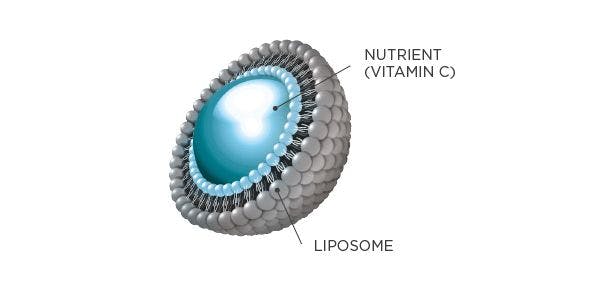Ultimate Guide to Liposomal Technology
- Author – Jackie Newson BSc Hons, Nutritional Therapist
- Editor – Susie Debice BSc Hons, Dip ION, Food Scientist and Nutritional Therapist
"Comparing the absorption and utilisation of all other oral vitamin delivery with Altrient’s oral liposomal delivery is like comparing a squirt gun to a fire hose."
Dr Thomas Levy

Introduction
One of the biggest issues with health food supplements is being sure that they actually make a difference. Do they work? Are they properly absorbed and do the nutrients reach the cells that need them? Until the development of liposomal encapsulation technology (LET) there was no certainty. Unfortunately, no matter how advanced a formula is, it’s efficacy may be limited by its rate of absorption.
To benefit from any kind of nutraceutical product the active components need to be able to reach the target tissue of action and this may be negatively impacted by a range of gastrointestinal factors.

Standard forms vs liposomal forms
Standard oral tablets and capsules may fall short when it comes to delivering their full therapeutic potential because of the actions of enzymes in the stomach and intestinal tract, which could degrade the product. The absorption process may be further hindered by the integrity of the intestinal lining or the addition of fillers, binders, gelatins and sugar, which may lead to incomplete disintegration, reducing bioavailability of the active components2. What’s more, some nutrients may be unable to cross cell membranes efficiently.
However, by utilising liposomal encapsulation technology, nutritional supplements actually meet user expectations by maximised absorption and efficient uptake in the body. In some cases, research suggests that liposomal encapsulation technology supplementation almost achieves the same efficacy as intravenous therapy3,4.
The origins of liposomes
Liposomes were first discovered by British haematologist Dr Alec D Bangham FRS in the mid 1960s during his experiments to determine how lipids behave when immersed in water3. He discovered that liposomes have a remarkable structural resemblance to human cell membranes and similar encapsulation properties, which offered cell biologists a unique tool to isolate and study individual proteins and various cell membrane functions5,6.
Several years later creative scientists realised the potential for liposomes as drug carriers, especially since the manipulation and design of liposomes enables them to target specific cell sites and remain in circulation longer. Liposomal encapsulation technology was later developed introducing an innovative carrier system for therapeutically active compounds which represented a dramatic breakthrough in delivery systems7.

What is a liposome and how does LET work?
Liposomal encapsulation technology is a cutting-edge technological method of making liposomes – microscopic bubbles that encapsulate various substances. The name liposome originates from two Greek words – lipos and soma – ‘lipos’ meaning fat and ‘soma’ meaning body.
Liposomes are tiny artificially prepared lipid vesicles that are globular in shape. They are constructed from phospholipids, which consist of a hydrophilic or 'water loving' head and a hydrophobic or 'water fearing' tail. When dry phospholipids are immersed in watery solutions in a laboratory environment, they spontaneously arrange themselves into two parallel layers and form hollow spherical structures. These structures consist of one sphere inside another, forming a doubled-layered (bilayer) wall or membrane that surrounds the sphere3.
As the phospholipid membrane is amphiphilic it has the ability to capture both hydrophilic and hydrophobic therapeutic agents. This gives liposomes a significant advantage as they have the ability to incorporate and release both water-soluble and fat-soluble components simultaneously, whilst maintaining a protective barrier around their biologically active ingredients. The contents of the liposome are effectively delivered when the lipid bilayer fuses with another bilayer such as a cell membrane3,8.
The liposomal encapsulation technology system has unique characteristics that help enhance the absorption and efficiency of supplements. With liposomal encapsulation technology it is possible to:
- Increase ingredient solubility
- Repel degradation by digestive juices in the gastrointestinal tract due to protection from the liposome’s phospholipids bilayer
- Slow down nutrient release
- Buffer against extreme pH and temperature
- Increase resistance to free radicals produced in the body
- Increase resistance to intestinal flora
- Protect the contents from oxidation
- Enhance intracellular nutrient uptake
- Ensure contents are delivered undamaged to target areas
- Avoid immune system activation7
What’s more, the fatty substances (lipids) used for the preparation of liposomes are predominantly phospholipids such as phosphatidylcholine. These form bilayers that mimic those found in human cell membranes. Phosphatidylcholine is naturally occurring and is a major constituent of cell membranes providing structure, whilst also maintaining the permeability barrier. Natural phospholipids are unstable, so liposomes are prepared using synthetic phospholipids from a natural source and these are found to be remarkably safe7.
CROSS SECTION OF A LIPOSOME

The many functional applications of liposomal encapsulation technology today
Liposomal encapsulation technology has advanced rapidly since it was discovered decades ago and continues to offer a unique form of delivery that bypasses the obstacles normally encountered by more traditional oral forms of pharmaceutical drugs. This innovative technology has until relatively recently, only been harnessed by the medical and pharmaceutical industry as a method of specialised drug delivery.
Nowadays liposomes are used extensively from drug and gene delivery to diagnostics and cosmetics. They have also been utilised within the agriculture and food industry as versatile carriers for the protection and delivery of various different materials including food flavours and nutrients. There is also considerable interest in the ability of liposomes to incorporate food antimicrobials that could aid in the protection of food products against harmful bacteria18.
Liposomal encapsulation technology and health food supplements
It seems only natural that the nutraceutical industry would take advantage of this ground-breaking technology given the remarkable benefits of liposomal encapsulation technology. However, to date only a handful of leading manufacturers have embraced its potential for enhancing the delivery of oral supplementation. Considering the significant advantages this novel application has over traditional oral tablets and capsules for supplements containing standard forms of nutrients, very few companies are exploring the benefits.
Altrient – the original liposomal nutrients
LivOn Labs are amongst those that recognised the potential for liposomes to improve nutrient delivery and were in fact pioneers of liposomal encapsulation technology. Their researchers have been manufacturing and formulating high-quality liposomal supplements since 2004. Their liposomal products are currently marketed under the Altrient trademark.
The liposomes used in Altrient products are made from essential phospholipids that include a high percentage of phosphatidylcholine. These liposomes not only provide optimum protection and superior transport, they also satisfy the body’s requirements for phosphatidylcholine, omega 6 fatty acids and choline4.
Each Altrient formula has been researched and developed for at least 24 months with developers who have over 25 years of experience in liposomal encapsulation technology. Samples are tested at regular intervals for active ingredient content, changes in consistency and encapsulation efficiency of the active nutrient. This ensures that the final approved formula provides a consistently stable liposomal supplement.
Why are phospholipids so important?
There are a number of different types of phospholipids including phosphatidylcholine, known as an essential phospholipid since it cannot be made by the body, so must be sourced from food or supplements. The phosphatidylcholine used in liposomal encapsulation technology is a purified extract of lecithin and helps to provide a daily supply of this essential nutrient. Phosphatidylcholine is an important component of a balanced diet with documented positive effects on patient overall wellbeing9. The results of many studies have shown that phosphatidylcholine has a positive impact in many diseases.
Of the vast number of molecules that make up a living cell, phosphatidylcholine has emerged from studies as being one of the most prominent and fundamental, playing a key role in many actions in the body9. As well as providing structure and protection to cells it is also required for other vital functions including:
- Neurotransmitter signalling
- Fat metabolism
- Liver health
- Memory
In addition to this phosphatidylcholine is needed for the production of important messenger molecules called prostaglandins. These essential compounds have a range of functions including regulating the contraction and relaxation of muscles.
What are the health benefits of choline?
Choline: a component of phosphatidylcholine plays an important role in the synthesis of neurotransmitters that allow nerve cells to communicate with muscles and each other. Their role is vital for optimum heart and brain function.
Bile flow: As a constituent of bile, phosphatidylcholine also helps to offset fatty build-up in the liver and maintain gallbladder function. It shows a highly effective ability to deliver its essential fatty acid components directly into cells9,10.
Homocysteine management: As well as this phosphatidylcholine is shown to be a key nutrient in terms of healthy homocysteine levels due to its choline content, which is essential for the methylation of homocysteine to methionine. This is supported by research which shows that choline contributes to normal homocysteine metabolism.
Elevated levels of homocysteine have been associated with an increased risk for a number of chronic conditions including cancer, cardiovascular disease and cognitive decline. Results from several studies suggest that elevated homocysteine concentrations may lead to cardiovascular diseases11.
One of the many benefits of using phosphatidylcholine in supplement form is that it has an advantage over choline, which when administered in excessive doses is associated with a build-up of trimethylamine, a metabolic by-product of choline, which is attributed to a fishy odour emanating from the skin10.
Cholesterol balance: Research shows that choline contributes to normal lipid metabolism. Indeed, results from several studies show that taking phosphatidylcholine may be a useful way to help support cholesterol balance, particularly for people diagnosed with primary hyperlipidaemia9,12,13,14.
Gallstones: Research has identified that choline contributes to the maintenance of normal liver function, which may be why phosphatidylcholine has been shown to have a protective effect against gallstone formation14,15.
Phosphatidylcholine may also have a role to play in supporting liver function in conditions such as viral hepatitis and alcoholic fibrosis. Supplementation with phosphatidylcholine was shown to offer significant support for symptoms and liver function recovery9. These benefits are all likely due to the rich content of choline in phosphatidylcholine.
Six quick liposome facts
Liposomes mimic the highly complex bilayer structure of human cell membranes.
Liposomes have been used in tissue engineering as a strategy for promoting the regeneration of tissues for the human body16.
Liposome–DNA complexes were first tested as therapeutic agents in humans in 1993 21.
The largest use of liposomes and their encapsulating properties is in the multibillion-dollar personal care industry21.
Phosphatidylcholine contained in liposomes is one of the most abundant phospholipids in plants and animals.
Fat soluble nutrients can be inserted into the bilayer membrane of liposomes, whilst water soluble nutrients can be entrapped in the aqueous centre7,18.

What are the advantages of liposomal encapsulation technology?
Vitamin C is a key example of the full potential of using liposomal encapsulation technology, which helps to increase absorption of vitamin C into cellular systems by as much as ten times compared to oral capsule or tablet formulations14. Vitamin C has great value in human health, which has been well documented in thousands of studies. Its physical properties make it an ideal candidate for liposomal encapsulation and delivery.
Unfortunately, human bodies have lost the capacity to synthesise vitamin C in the liver unlike many animals, which means humans must obtain this vital nutrient through dietary intake. Some animals are capable of producing extremely high levels of vitamin C in times of stress or illness. Studies suggest that goats which normally produce approximately 13,000mg a day can produce up to 100,000mg a day when faced with severe health challenges4.
The extensive health benefits of vitamin C are limited due to the body’s inability to absorb high doses successfully. Vitamin C plasma concentration is normally controlled by three primary mechanisms:
- intestinal absorption
- tissue transport
- reabsorption by the kidneys
Once plasma levels of vitamin C reach saturation point this water-soluble vitamin is rapidly eliminated from the body through the urine.
Vitamin C intestinal flush
When vitamin C is taken in the form of ascorbic acid, at doses up to 200mg at a time, it is possible to absorb around 98%. The absorption rate declines to as little as 33% once the dose of vitamin C exceeds 1.2g and continues to decrease as the dose increases. Excess vitamin C remaining in the gut attracts water from the intestinal contents causing a diarrhoea flushing effect – one of the only proven adverse effects of high dose vitamin C intake.
Liposomal vitamin C is kind to the gut
The unique delivery system of liposomal encapsulation technology ensures a near complete uptake of vitamin C into the bloodstream by avoiding some of the usual hazards that contribute to poor absorption.
By wrapping vitamin C into a liposome, the body continues to absorb it over time and it stays in the bloodstream longer, so plasma levels increase and stay at those higher levels for a longer period4. The physical qualities of the liposomes bypass the digestive constraints normally encountered by traditional oral supplements, providing an exceptionally effective level to the target cells.
Whilst vitamin C is a fine example of the improvements brought about by liposomal encapsulation technology this superior form of supplementation has the capability of enhancing absorption and efficacy of many other important nutrients and should be seriously considered by those who value their health and longevity.
The top five advantages of Altrient liposomal supplements
Maximised absorption and uptake into cells compared with other oral forms of supplements.
Gentle on the stomach – Altrient liposomes deliver high doses without any gastrointestinal discomfort.
Ease and convenience – Ideal for those for whom swallowing a tablet is not possible.
Cost effective – No need for high doses as lower doses have the same effect8.
Superior formula – Liposomes provide superior therapeutic efficacy and safety in comparison to existing formulations

How safe is liposomal encapsulation technology?
Since their discovery in the mid 60s liposomes have been intensively researched as drug delivery vehicles. Their remarkable biocompatibility and resemblance to human cell membranes means they have little or no toxicity and have long been considered safe carriers for a variety of delivery routes including nutritional supplementation2,19. Jacqueline Newson BSc (Hons) Nutritional Therapy

REFERENCES
Skeie, G., Braaten, T., Hjartåker, A. et al. Use of dietary supplements in the European Prospective Investigation into Cancer and Nutrition calibration study. Eur J Clin Nutr 63, S226–S238 (2009).
Smith TK and Young SA (2015). Lipids and Liposomes in the Enhancement of Health and Treatment of Disease. https://www.intechopen.com/books/drug-discovery-and-development-from-molecules-to-medicine/lipids-and-liposomes-in-the-enhancement-of-health-and-treatment-of-disease. [Accessed 6.7.20]
Davis JL, Paris HL, Beals JW, et al. Liposomal-encapsulated Ascorbic Acid: Influence on Vitamin C Bioavailability and Capacity to Protect Against Ischemia-Reperfusion Injury. Nutr Metab Insights. 2016;9:25-30.
Milne RD (2004). PC Liposomal Encapsulation Technology. Life’s Fountain Books: Nevada.
Gregoriadis G. Liposomes in Drug Delivery: How It All Happened. Pharmaceutics. 2016;8(2):19.
Safinya, C., Ewert, K. Liposomes derived from molecular vases. Nature 489, 372–374 (2012).
Suntres ZE. Liposomal Antioxidants for Protection against Oxidant –Induced Damaged. Journal of Toxicology 2011; 152474:1-16.
Shade CW. Liposomes as Advanced Delivery Systems for Nutraceuticals. Integr Med (Encinitas). 2016;15(1):33‐36.
Kullenberg D, Massing U & Schneider M et al. Health effects of dietary phospholipids. Lipids in Health and Disease 2012. 11:3.
Knuiman JT, Beynen AC, Katan MB. Lecithin intake and serum cholesterol. Am J Clin Nutr 1989;49:266-8.H Kullenberg D, Massing U & Schneider M et al. Health effects of dietary phospholipids. Lipids in Health and Disease 2012. 11:3.
Da Costa KA, Zeisel S H. Choline: an essential nutrient for public health. Nutrition Reviews 2009. 67; 11:615-623.
Childs MT, Bowlin JA, Ogilvie JT, et al. The contrasting effects of a dietary soya lecithin product and corn oil on lipoprotein lipids in normolipidemic and familial hypercholesterolemic subjects. Atherosclerosis 1981;38:217-28.
Wilson TA, Meservey CM, Nicolosi RJ. Soy lecithin reduces plasma lipoprotein cholesterol and early atherogenesis in hypercholesterolemic monkeys and hamsters: beyond linoleate. Atherosclerosis 1998;140:147-53.
Toouli J, Jablonski P, Watts JM. Gallstone dissolution in man using cholic acid and lecithin. Lancet 1975; ii:1124-6.
Tuzhilin SA, Dreiling D, Narodetskaja RV, Lukahs LK. The treatment of patients with gallstones by lecithin. Am J Gastroenterol 1976;165:231-5.
Monteiro N, Martins A, Reis RL, Neves NM. Liposomes in tissue engineering and regenerative medicine. J R Soc Interface. 2014;11(101):20140459.
Bulbake U, Doppalapudi S, Kommineni N, Khan W. Liposomal Formulations in Clinical Use: An Updated Review. Pharmaceutics. 2017;9(2):12.
Safinya, C., Ewert, K. Liposomes derived from molecular vases. Nature 489, 372–374 (2012).
Bozzuto G, Molinari A. Liposomes as nanomedical devices. Int J Nanomedicine. 2015;10:975-999.
Hua S et al. Advances and Challenges of Liposome Assisted Drug Delivery. Front. Pharmacol. 2015.
Maciej Łukawski, Paulina Dałek, Tomasz Borowik, Aleksander Foryś, Marek Langner, Wojciech Witkiewicz & Magdalena Przybyło. New oral liposomal vitamin C formulation: properties and bioavailability. Journal of Liposome Research 2019: 1-8.
Shade CW. Liposomes as Advanced Delivery Systems for Nutraceuticals. Integr Med (Encinitas). 2016;15(1):33‐36.
Taylor TM, Davidson PM, Bruce BD, Weiss J. Liposomal nanocapsules in food science and agriculture. Crit Rev Food Sci Nutr. 2005;45(7-8):587-605.
Download this Ultimate Guide for FREE
Please enter your details to download our guide "Ultimate Guide to Liposomal Technology". By submitting this from you agree to the Terms and conditions
There was an issue with your submission, please click here to contact us.
Thank you, your submission has been received and your download will start shortly. If not then please click here to download
